In today’s fast-paced business environment, fostering a culture of continual growth and open feedback is not just beneficial, but essential. At the forefront of this progressive culture is the start stop continue feedback, a dynamic tool promoting organizational excellence.
Let's navigate the intricacies of start stop continue feedback with Start Stop Continue examples to pave the way for a positive and transformative organizational culture.

What Is the Start Stop Continue Feedback
The start stop continue framework is more than just a feedback mechanism; it's a catalyst for fostering growth and innovation within an organization. It embodies a triple-faceted approach that identifies and magnifies strengths (continue), pinpoints areas necessitating improvements (stop), and explores opportunities for fresh advancements (start).
This method encourages participants to think critically about their actions and strategies, making it a potent tool for nurturing a culture of continuous improvement and transparency. By leveraging the start stop continue feedback model, organizations can work collaboratively to build a roadmap for success, making adjustments that are grounded in insightful, actionable feedback.
Who Should Conduct the Start Stop Continue Exercise
In any organization, the start stop continue exercise can be initiated and led by various stakeholders, depending on the goals and context. This exercise's flexibility allows different levels of leadership and team members to participate actively. Here's an overview of who should consider conducting the start stop continue exercise:
- Top-Level Management: Executives at the highest levels of the organization, including CEOs, COOs, and department heads, play a crucial role in setting the company's strategic direction. They should engage in this exercise to ensure that feedback aligns with the organization's long-term vision and goals. Additionally, it allows them to communicate the company's vision effectively and inspire collective efforts toward achieving it.
- Project Managers:Project managers are responsible for the successful execution of specific projects or initiatives. They should actively conduct the start stop for project progress management, make necessary adjustments, and ensure the effectiveness of project teams. This exercise aids in identifying potential project risks and helps meet project timelines effectively.
- Team Leaders:Team leaders and supervisors are responsible for guiding and coordinating the efforts of their team members. They should engage in this exercise to enhance team cohesion, identify areas for improvement, and promote open communication within the team. It contributes to better team dynamics, performance, and problem-solving.
- Colleagues and Team Members:Colleagues and team members themselves should actively initiate the start stop continue exercise. Encouraging peer-to-peer feedback fosters a culture of open dialogue, mutual respect, and continuous improvement within teams. It promotes shared responsibility for collective growth, incorporates diverse perspectives, and enhances collaboration.
10 Start Stop Continue Examples for Diverse Groups of People
Some of the start stop continue examples for groups of people mentioned above are as follow:
Stop Start Continue Feedback Example for Managers
Stop: Stop the practice of micromanaging your team. Instead, trust your employees with the autonomy to make decisions within their roles. By doing so, you not only foster trust but also empower your team members to take ownership of their work. This newfound independence can lead to increased job satisfaction and improved problem-solving abilities.
Start: Start a series of regular brainstorming sessions with your team to cultivate a culture of innovation. These sessions should provide an inclusive environment where team members feel comfortable proposing new ideas and solutions. Encourage fresh perspectives and unconventional thinking, as these can often lead to breakthrough innovations that drive the organization forward.
Continue: Continue a consistent practice of recognizing and rewarding outstanding performance within your team. This recognition fosters a positive work environment, boosting employee morale and motivation. Additionally, it reinforces the behaviors and outcomes that contribute to the team's success, ensuring they continue to excel.
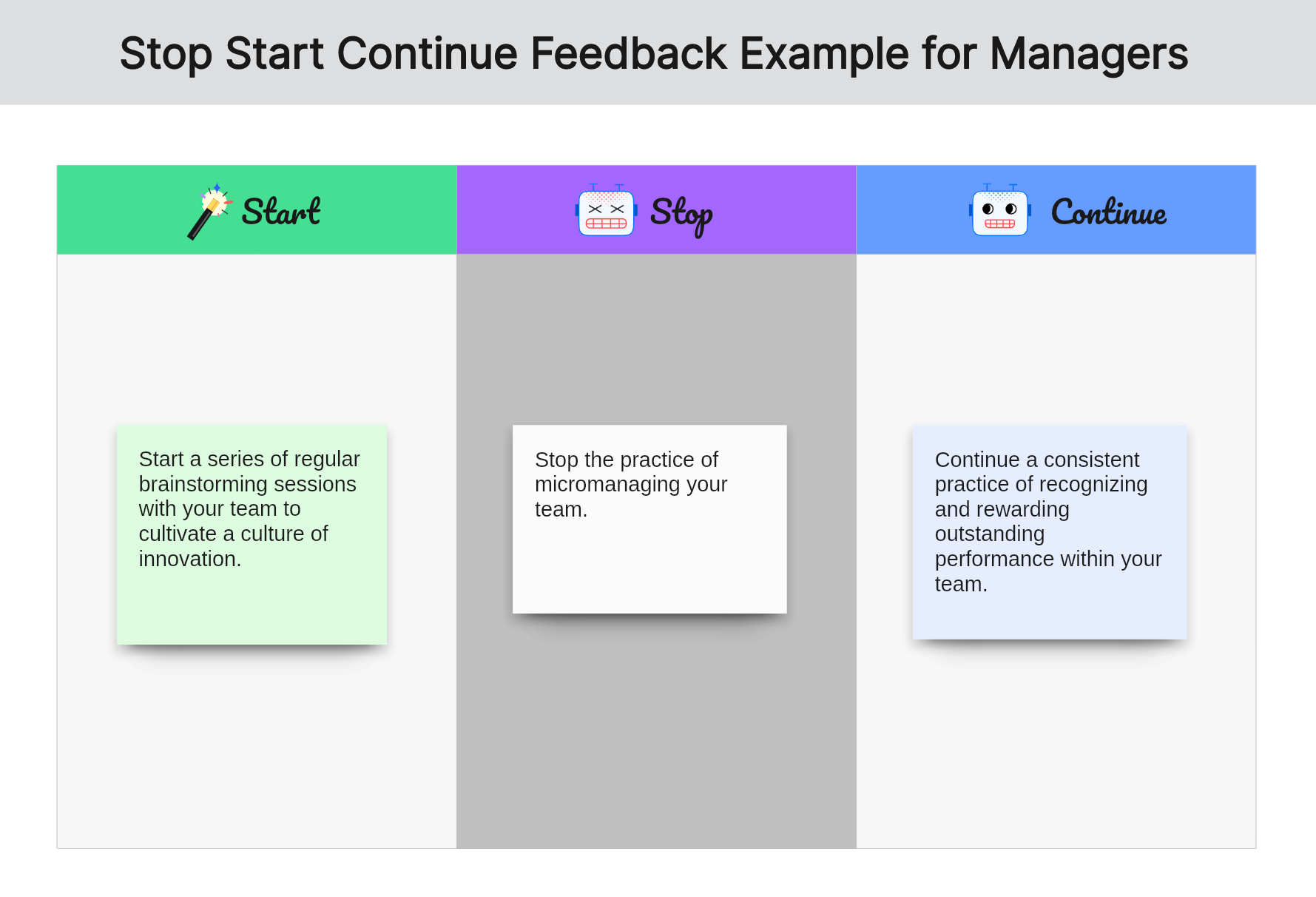
Stop Start Continue Example for Project Managers
Stop: Stop neglecting potential risks that could derail project timelines. Implement proactive risk management strategies to identify and mitigate potential issues before they become major roadblocks.
Start: Start adopting adaptive project management approaches. In today's dynamic business landscape, flexibility is key. Embrace changes and adapt your project plans as needed to ensure success.
Continue: Continue maintaining open communication channels with your team. Regular updates and transparent communication facilitate better collaboration and problem-solving.

Start Stop Continue Example for Your Boss
Start: Start adopting a more inclusive decision-making process. Seek input and ideas from employees before making significant decisions. This can lead to better solutions and higher morale.
Stop: Stop disregarding employee feedback and suggestions. Every team member's perspective is valuable, and dismissing their input can create frustration and disengagement.
Continue: Continue promoting a healthy work-life balance for all employees. This helps maintain a motivated and well-rested workforce.
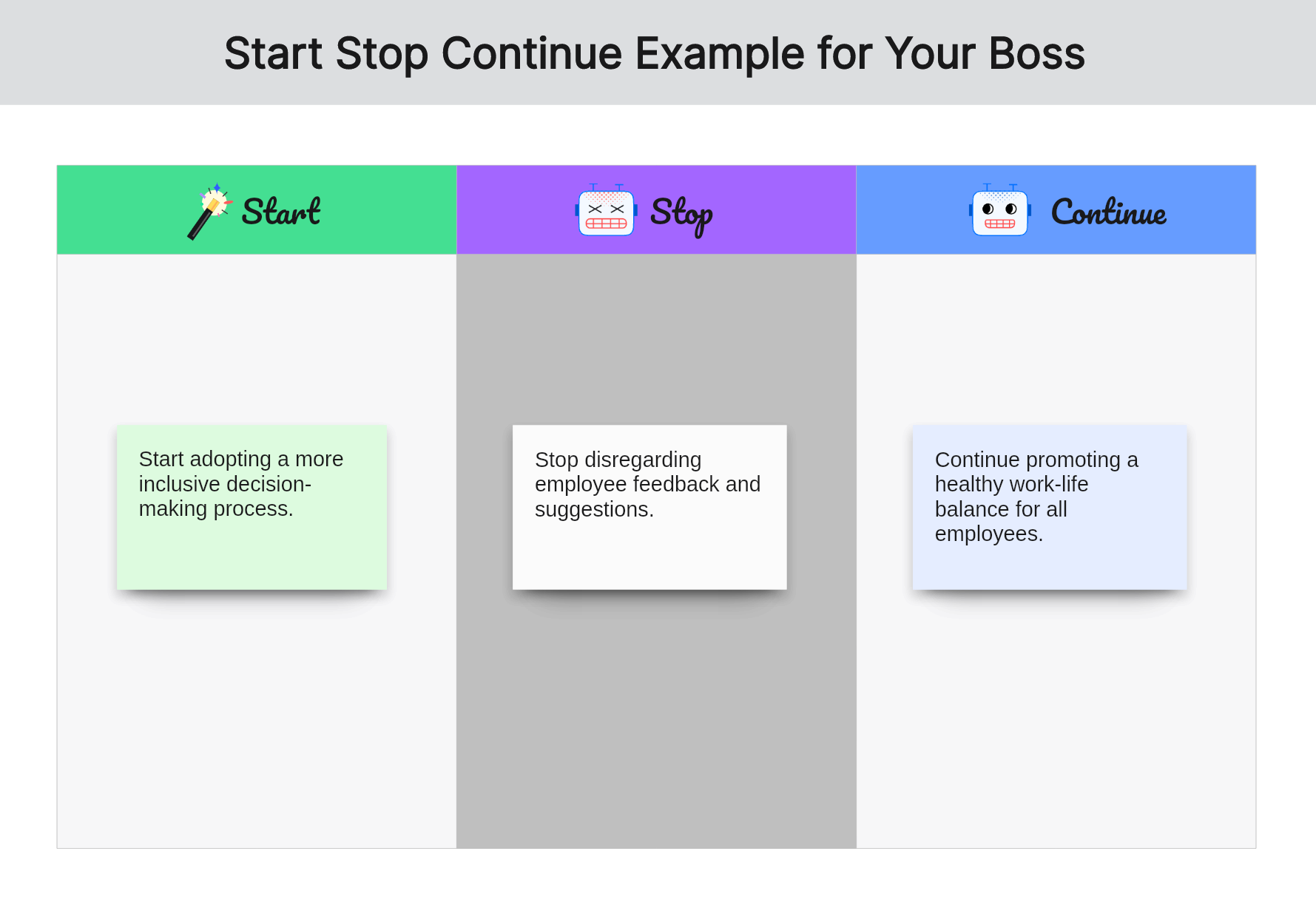
Stop Start Continue Example for Leaders
Start: Start the process of embracing a transformational leadership style. This approach involves inspiring the team with a compelling vision, providing mentorship and support, and empowering individuals to reach their full potential. Transformational leaders lead by example, and their actions inspire others to grow and excel.
Stop: Stop the resistance to change and the clinging to outdated processes. Instead, leaders should actively encourage their teams to explore new ideas and methods. A culture that embraces change and innovation is more adaptable and better positioned for long-term success in a rapidly evolving business environment.
Continue: Continue investing in their personal development and learning. Leading by example, leaders demonstrate a commitment to growth and improvement. This commitment not only enhances their own leadership abilities but also motivates others to pursue their own development, creating a culture of continuous learning and improvement.
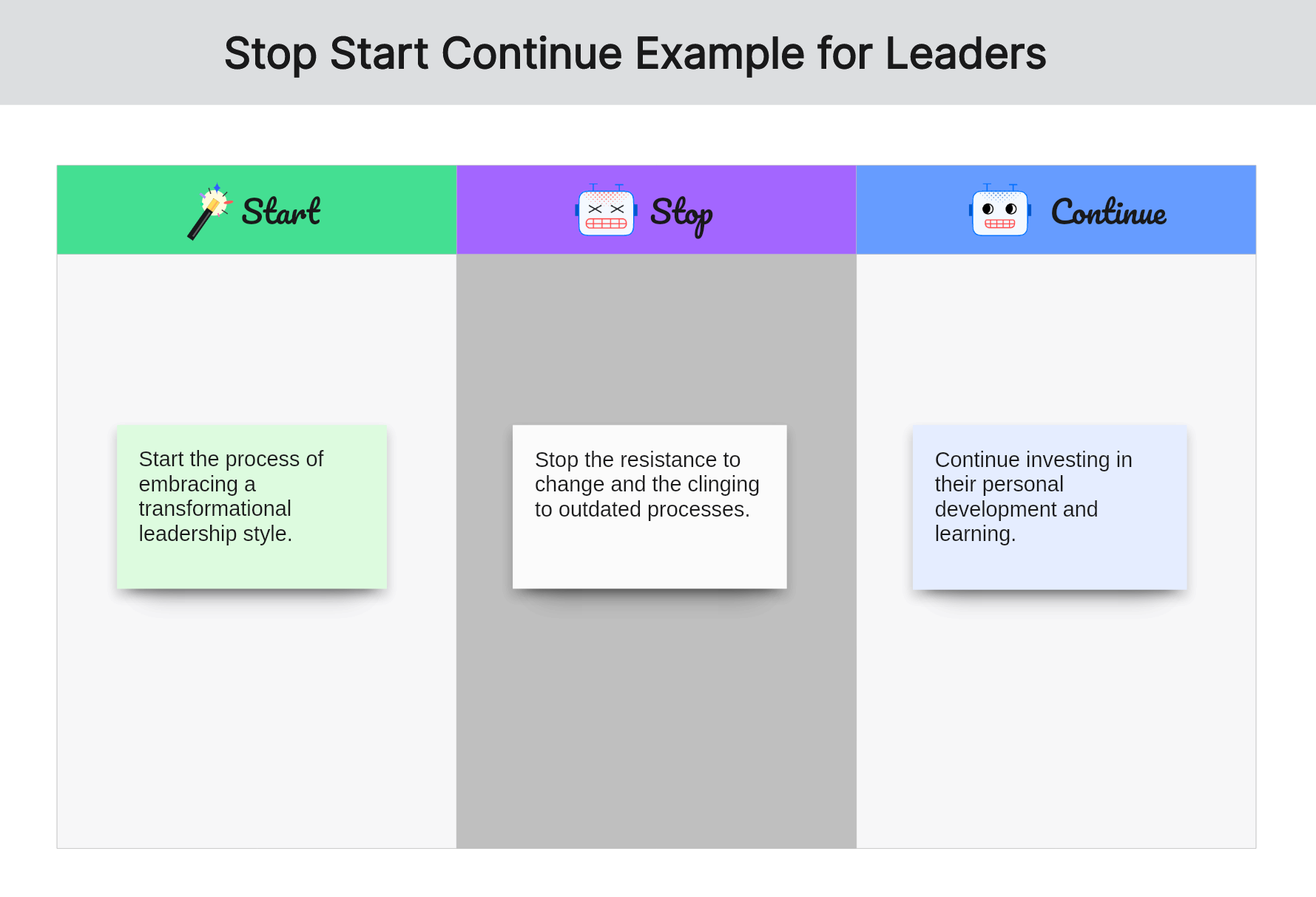
Start Stop Continue Example for Teams
Start: Start cross-functional collaborations within the team to foster innovation. Encourage team members from different departments to work together on projects, bringing diverse perspectives to the table.
Stop: Stop working in silos. Encourage more group discussions and information sharing among team members. This can lead to more holistic problem-solving.
Continue: Continue building on the positive group dynamics and team synergy that you've developed. Recognize and celebrate teamwork to motivate team members further.
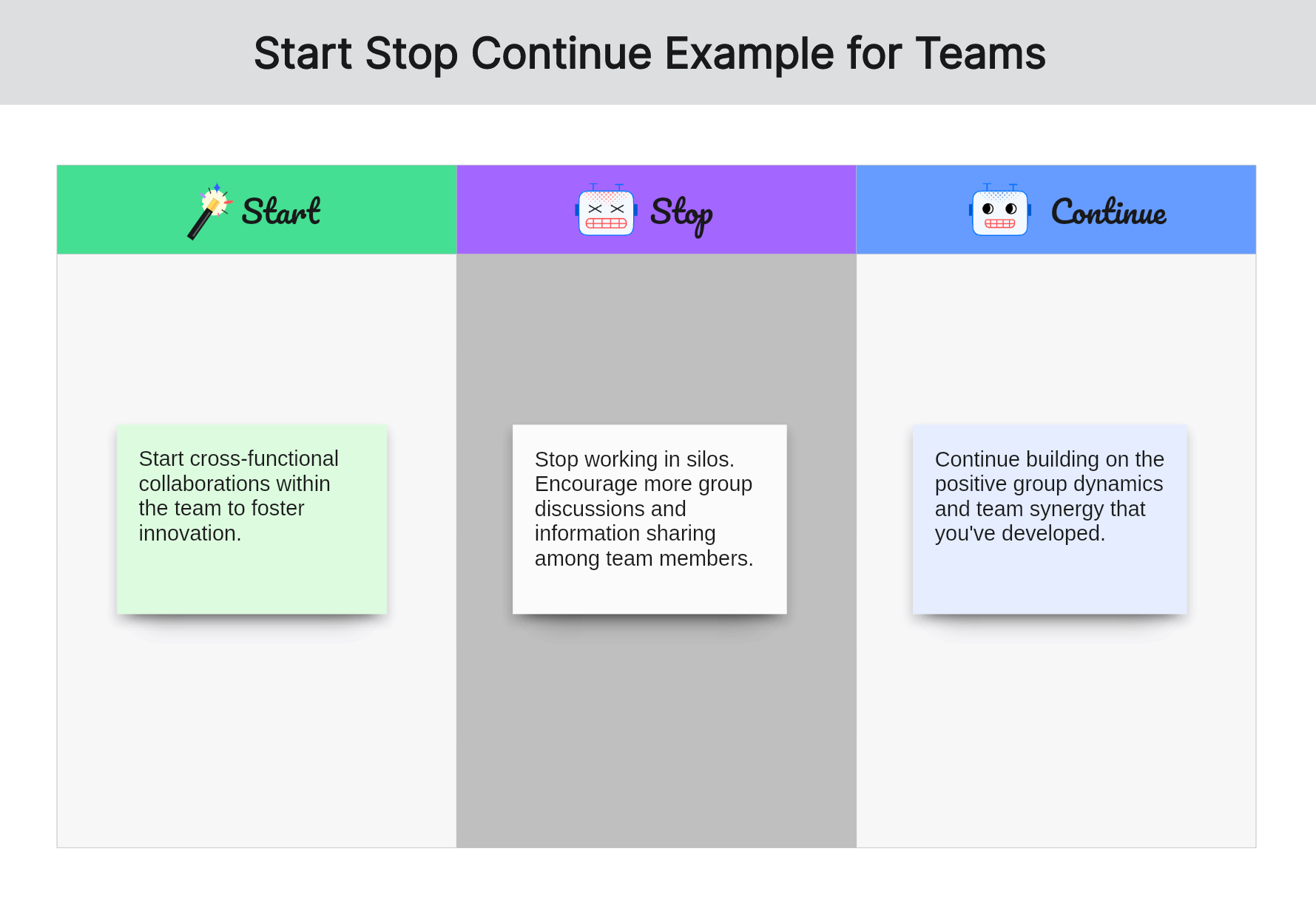
Start Stop Continue Example for Teams
Start: Start more team-building activities to strengthen team bonds. Activities like team lunches or offsite events can create a more cohesive and motivated team. Team-building activities enhance team cohesion and morale.
Stop: Stop avoiding constructive criticism. Constructive feedback is essential for personal and professional growth. Avoiding feedback can lead to missed opportunities for improvement.
Continue: Continue a collaborative and harmonious work environment. Continue fostering open communication and mutual respect among team members. Collaboration promotes a positive team atmosphere.
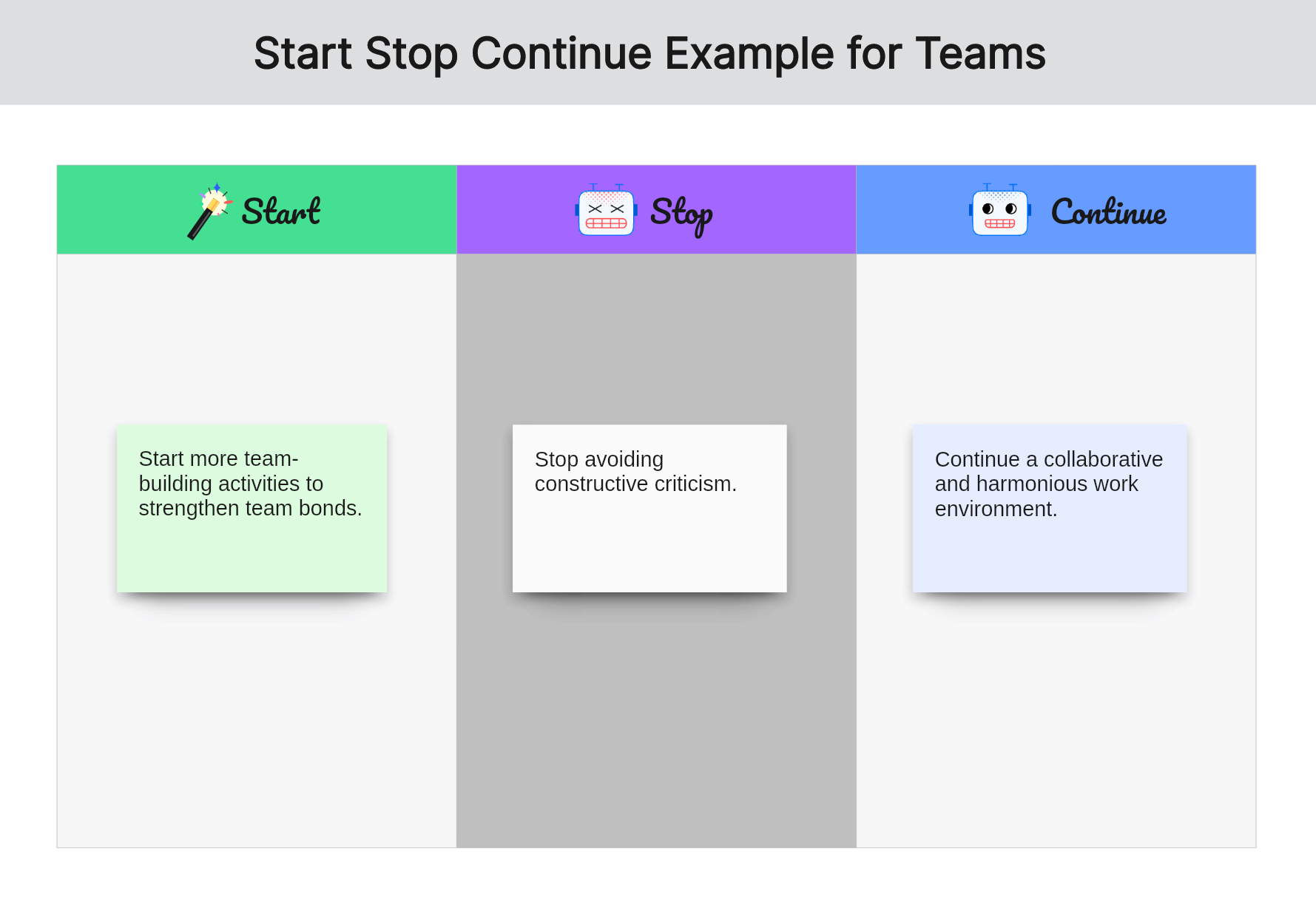
Stop Start Continue Examples for Employee
Stop: Stop hesitating to share opinions and feedback. Employees’ input is valuable for the organization's growth.
Start: Start proposing innovative solutions to challenges. Employees can actively contribute to the company's success by suggesting improvements.
Continue: Continue pursuing personal growth and development opportunities. Employees who invest in themselves become valuable assets to the organization.
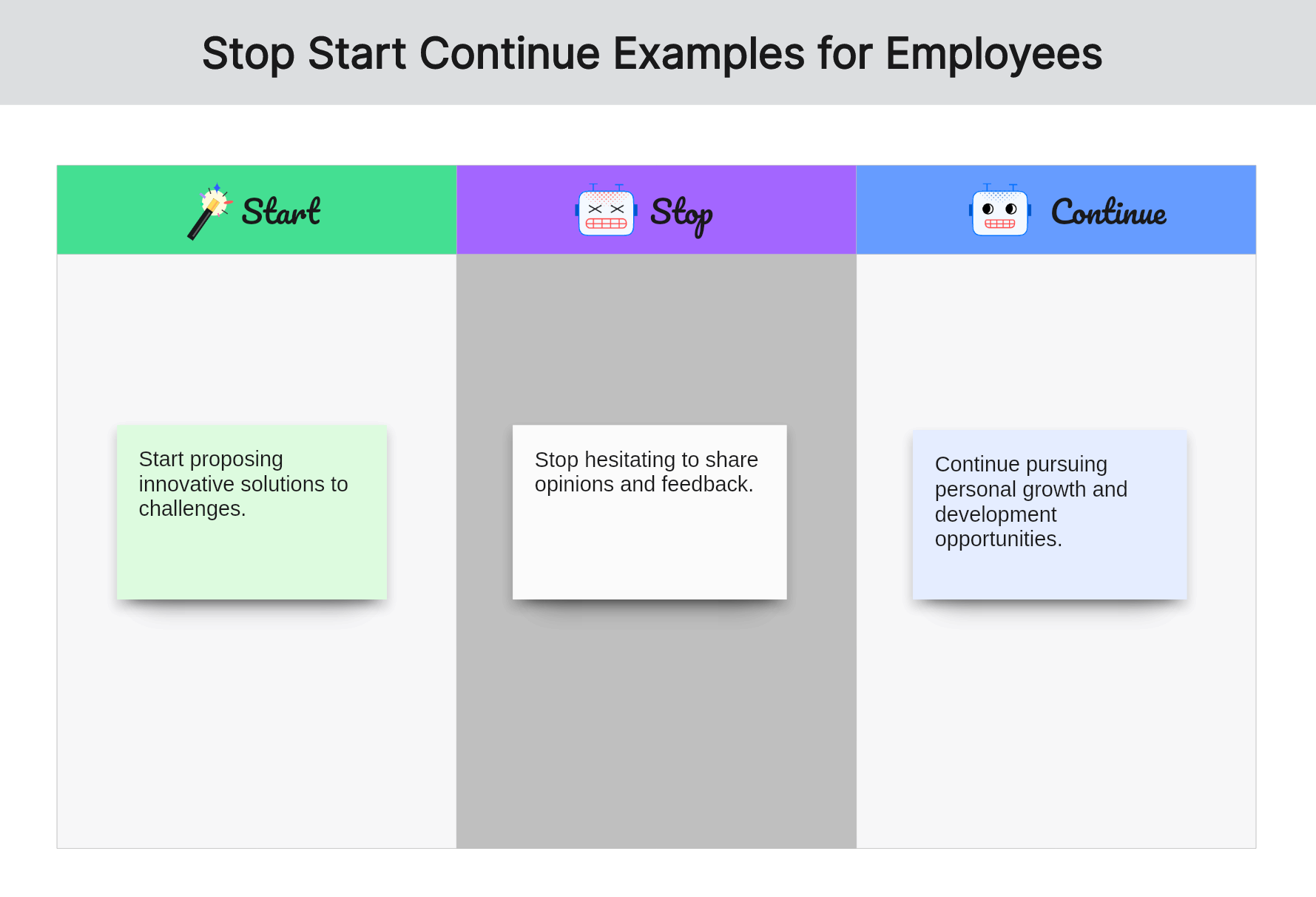
Stop Start Continue Examples for Employee
Stop: Stop resisting feedback and opportunities for growth. Embrace constructive criticism as a means to improve. Resisting feedback can hinder personal development.
Start: Start engaging more actively in company-wide initiatives and projects. This can lead to personal development and increased job satisfaction. Active engagement contributes to a positive work environment.
Continue: Continue a positive attitude and strong work ethic. Consistency in performance is key to long-term success within the organization. A positive attitude fosters a productive atmosphere.
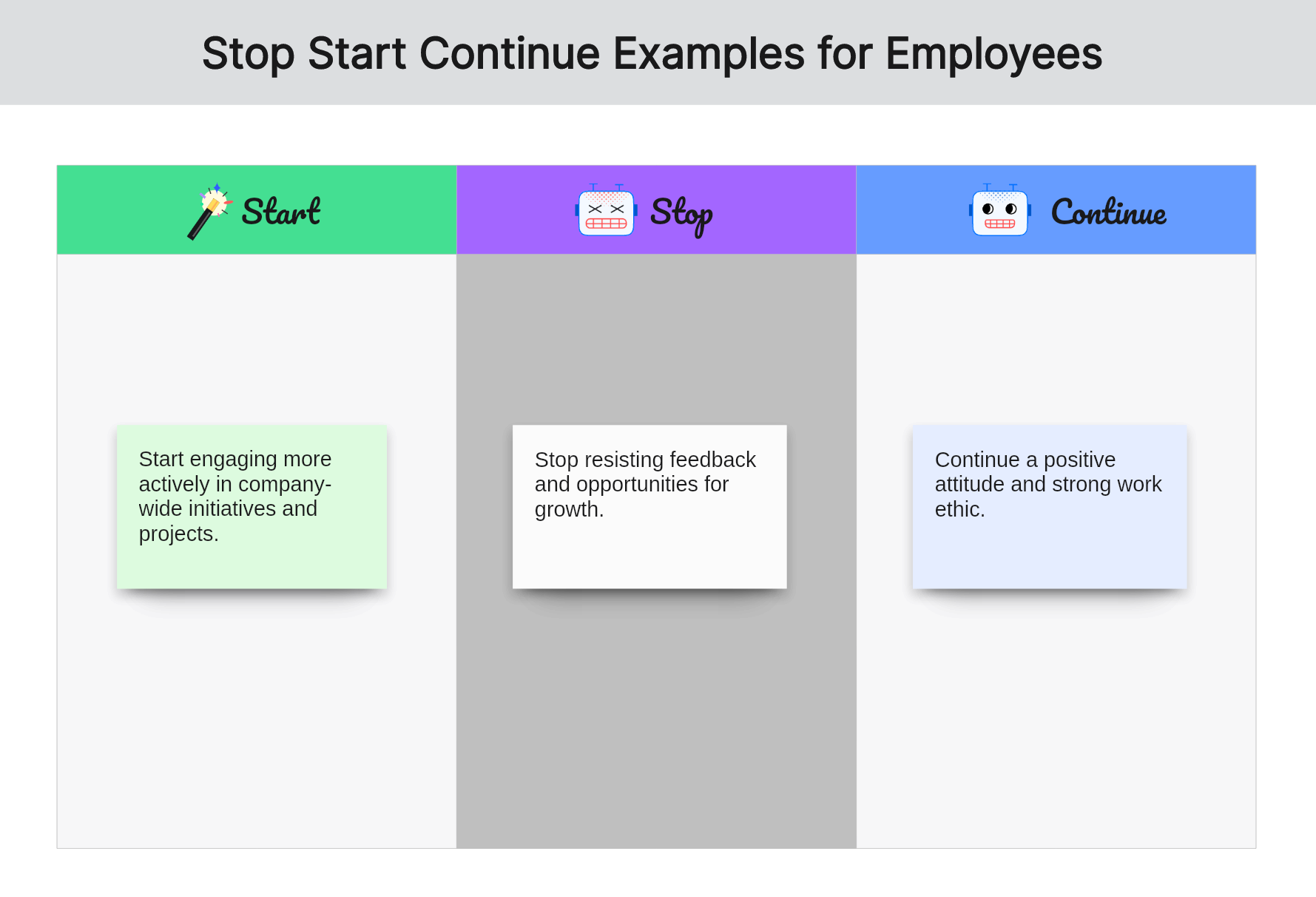
Stop Start Continue Feedback Example for Colleagues
Stop: Stop engaging in office politics and fostering negativity. Negative environments can hinder productivity and teamwork.
Start: Start open communication channels among team members. Encourage colleagues to share their ideas and concerns openly.
Continue: Continue collaborating and supporting each other to achieve common goals. A supportive work environment leads to better outcomes for everyone.
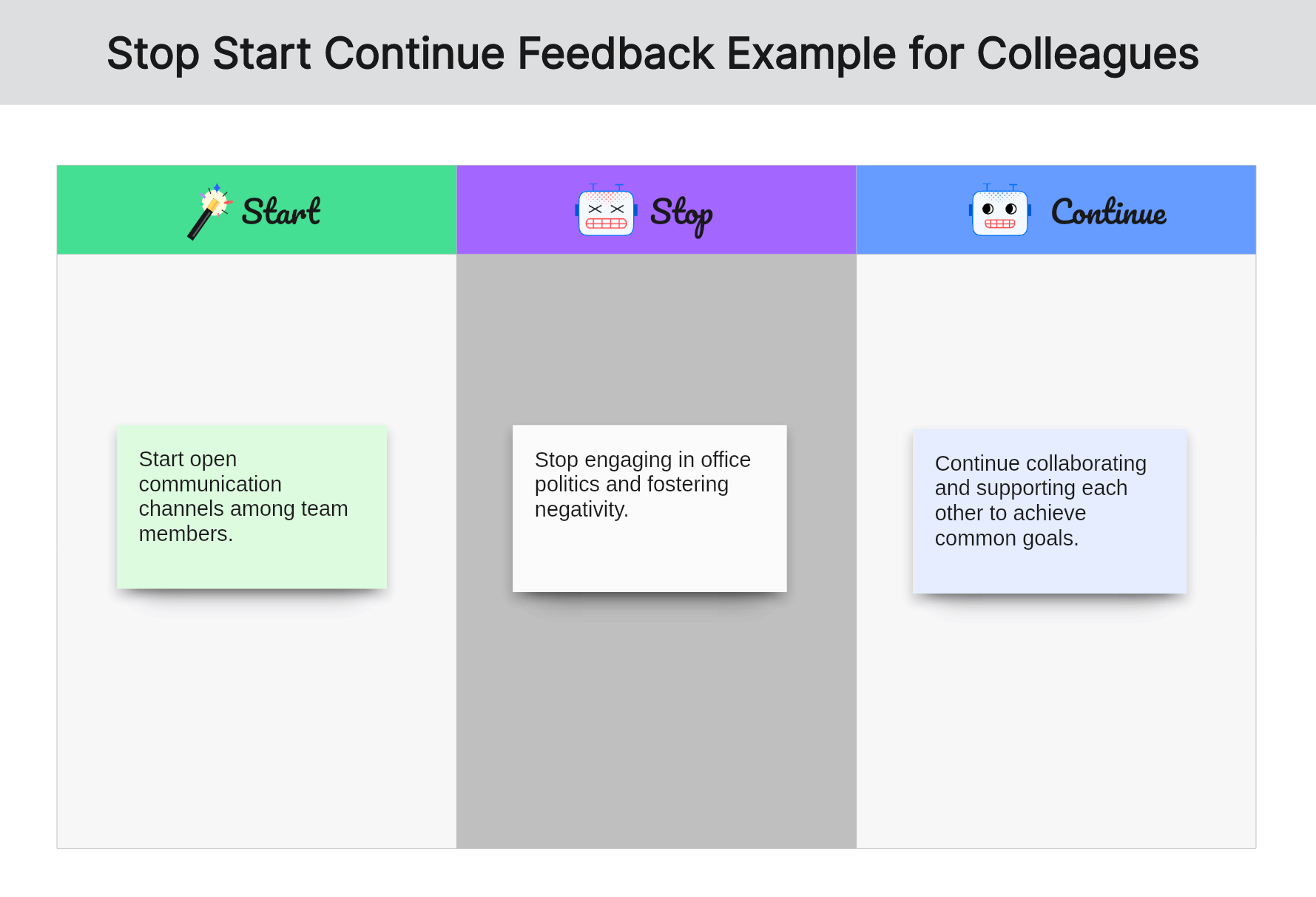
Stop Start Continue Feedback Example for Colleagues
Stop: Stop the practice of withholding valuable information is vital for team success. Transparency and open knowledge sharing are foundational for collaborative achievement. By eliminating information barriers, teams can make more informed decisions and work cohesively.
Start: Start introducing regular knowledge-sharing sessions and encourage colleagues to exchange insights and expertise. These structured meetings provide a platform for team members to share their experiences, fostering collective learning and innovation.
Continue: Continue a culture of mutual respect and understanding. This ensures a positive and inclusive workplace atmosphere, where every team member feels valued and heard. This, in turn, strengthens collaboration and drives the organization forward.
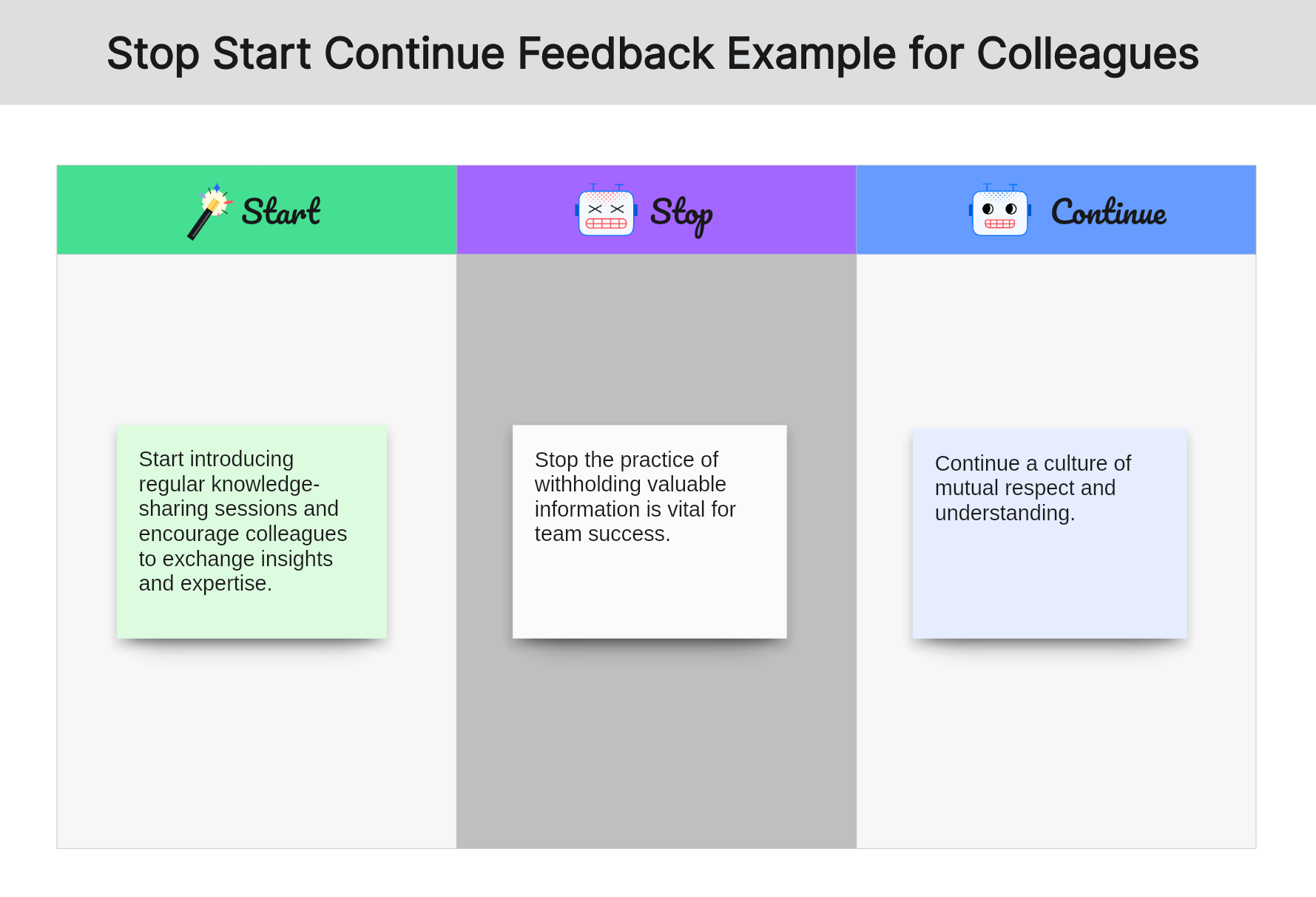
How to Better Perform the Start Stop Continue Exercise
Mastering the start stop continue exercise involves more than just going through the motions. To maximize its effectiveness and ensure that it leads to meaningful insights and actionable changes, consider the following strategies for better performance:
1. Set Clear Objectives
Define the specific goals you aim to achieve with the exercise. Whether it's improving team collaboration, enhancing individual performance, or aligning with cleat strategic objectives, clear objectives provide focus.
2. Foster Open and Honest Communication
Encourage participants to express their thoughts openly and honestly. Create a safe space where feedback can be given and received without fear of repercussions.
3. Provide Guidance and Structure
Offer clear guidelines and a structured framework for conducting the exercise. This helps participants understand the process and provides consistency in feedback collection.
4. Use a Thoughtful Approach
When giving feedback, be thoughtful and specific. Avoid vague or generalized comments. Describe behaviors or actions you'd like to see continued, stopped, or started.
5. Collect Anonymous Feedback
In some cases, anonymity can encourage more candid feedback. Consider using anonymous surveys or feedback forms to ensure that participants feel comfortable sharing their thoughts.
Key Takeaway: A Start Stop Continue Template and a One-stop Tool
Boardmix emerges as a dynamic catalyst in the realm of feedback and continuous improvement. This innovative platform offers a ready-made template that streamline the initiation of feedback sessions, creating an environment conducive to growth and progress within organizations. Its transformative capabilities position it as a one-stop solution, revolutionizing the way feedback is conducted and utilized.

Explore the transformative capabilities of Boardmix and discover how it stands as a real-time collaboration platform to facilitate cohesive and constructive feedback processes. Visit Boardmix to access an array of innovative solutions designed to meet the needs of modern organizations.









